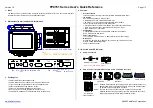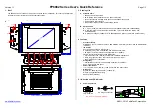
8
B. LOCAL STANDARDS AND AUTHORIZED PERSONS
Installation must be completed in accordance with local standards and regulations.
Installation must also be completed by a qualified tradesperson who holds relevant industry licenses or
certificates. The term “authorized person(s)” used throughout this document refers to a suitably qualified
professional. Unless otherwise specified in Part 3, no part of the HTP solar collector may be inspected,
repaired, or maintained by anybody other than an authorized person.
C. TERMINOLOGY
Solar terminology differs from region to region. To avoid confusion, please note the following:
Supply
– The plumbing line running from the outlet of the collector to the tank.
Return
– The plumbing line running from the tank (or heat exchanger) to the inlet of the collector. This
line incorporates the circulation pump.
D. POSSIBLE SYSTEM DESIGNS
1. OPEN LOOP SYSTEMS
An open loop system has potable water circulating through the solar collectors. Open loop systems are
recommended for hot or warm climates that rarely freeze. For rare incidents when ambient temperature
drops below freezing, the controller can be programmed to provide freeze protection by circulating warm
water from the tank through the solar collectors.
For open loop systems, the normal operating pressure should be less than 72.5 psi. This operating
pressure is provided via use of a pressure limiting/reduction valve on the main supply line. An expansion
tank is required in open loop systems.
An open loop system may allow the solar collectors to stagnate to prevent overheating of the storage
tank. In the event of component failure, the pressure relief valve must be able to release the increased
pressure, and should be rated to meet the maximum possible pressure output of the solar collector(s).
Please see Part 3 for sections regarding overheating.
2. CLOSED LOOP SYSTEMS
A closed loop system uses non-potable heat transfer fluid (HTF) and must be pressurized to less than
72.5 psi. Closed loop systems require an expansion tank to accommodate HTF expansion. The system
should be designed to minimize stagnation after the tank temperature has been met; extensive stagnation
may increase pH levels and glycol deterioration.
The expansion tank and plumbing must be properly sized so that the safety pressure relief valve will not
activate except in the event of component failure or extreme conditions. The pressure release must be set
at no more than 90 psi. (There may be exceptions in engineered designs for tall buildings.)
3. DRAIN BACK SYSTEMS
The drain back method provides effective overheating and freeze protection, making these systems well-
suited for all climates. When storage tank water temperature settings are reached or the collector
temperature falls below a set temperature, the pump shuts off, allowing the HTF to drain back into the
tank. Some drain back systems use distilled water as HTF. Others use a propylene glycol/water mix.
Drain back systems require larger pumps to move HTF up and into the solar collectors. Mounting the
drain back tank as high as possible within conditioned space will reduce pump size.
Summary of Contents for FP-26SC
Page 32: ...32 MAINTENANCE NOTES ...









































